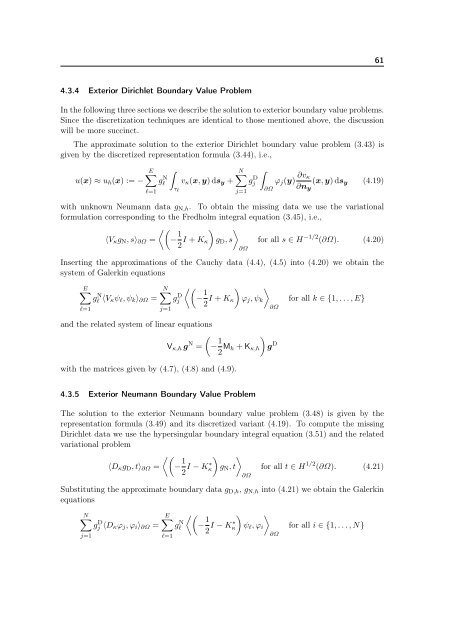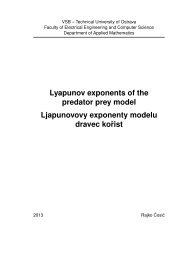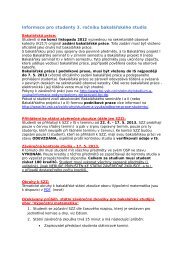The Boundary Element Method for the Helmholtz Equation ... - FEI VÅ B
The Boundary Element Method for the Helmholtz Equation ... - FEI VÅ B
The Boundary Element Method for the Helmholtz Equation ... - FEI VÅ B
Create successful ePaper yourself
Turn your PDF publications into a flip-book with our unique Google optimized e-Paper software.
614.3.4 Exterior Dirichlet <strong>Boundary</strong> Value ProblemIn <strong>the</strong> following three sections we describe <strong>the</strong> solution to exterior boundary value problems.Since <strong>the</strong> discretization techniques are identical to those mentioned above, <strong>the</strong> discussionwill be more succinct.<strong>The</strong> approximate solution to <strong>the</strong> exterior Dirichlet boundary value problem (3.43) isgiven by <strong>the</strong> discretized representation <strong>for</strong>mula (3.44), i.e.,u(x) ≈ u h (x) := −El=1g N lτ lv κ (x, y) ds y +Nj=1g D j∂Ωϕ j (y) ∂v κ∂n y(x, y) ds y (4.19)with unknown Neumann data g N,h . To obtain <strong>the</strong> missing data we use <strong>the</strong> variational<strong>for</strong>mulation corresponding to <strong>the</strong> Fredholm integral equation (3.45), i.e.,⟨V κ g N , s⟩ ∂Ω = − 1 2 I + K κ g D , s <strong>for</strong> all s ∈ H −1/2 (∂Ω). (4.20)Inserting <strong>the</strong> approximations of <strong>the</strong> Cauchy data (4.4), (4.5) into (4.20) we obtain <strong>the</strong>system of Galerkin equationsEgl N ⟨V κψ l , ψ k ⟩ ∂Ω =l=1Nj=1g D j∂Ω− 1 2 I + K κ ϕ j , ψ k∂Ωand <strong>the</strong> related system of linear equationsV κ,h g N =− 1 2 M h + K κ,h g Dwith <strong>the</strong> matrices given by (4.7), (4.8) and (4.9).<strong>for</strong> all k ∈ {1, . . . , E}4.3.5 Exterior Neumann <strong>Boundary</strong> Value Problem<strong>The</strong> solution to <strong>the</strong> exterior Neumann boundary value problem (3.48) is given by <strong>the</strong>representation <strong>for</strong>mula (3.49) and its discretized variant (4.19). To compute <strong>the</strong> missingDirichlet data we use <strong>the</strong> hypersingular boundary integral equation (3.51) and <strong>the</strong> relatedvariational problem⟨D κ g D , t⟩ ∂Ω = − 1 2 I − K∗ κ g N , t <strong>for</strong> all t ∈ H 1/2 (∂Ω). (4.21)∂ΩSubstituting <strong>the</strong> approximate boundary data g D,h , g N,h into (4.21) we obtain <strong>the</strong> GalerkinequationsNgj D ⟨D κ ϕ j , ϕ i ⟩ ∂Ω =j=1El=1g N l− 1 2 I − K∗ κ ψ l , ϕ i∂Ω<strong>for</strong> all i ∈ {1, . . . , N}









